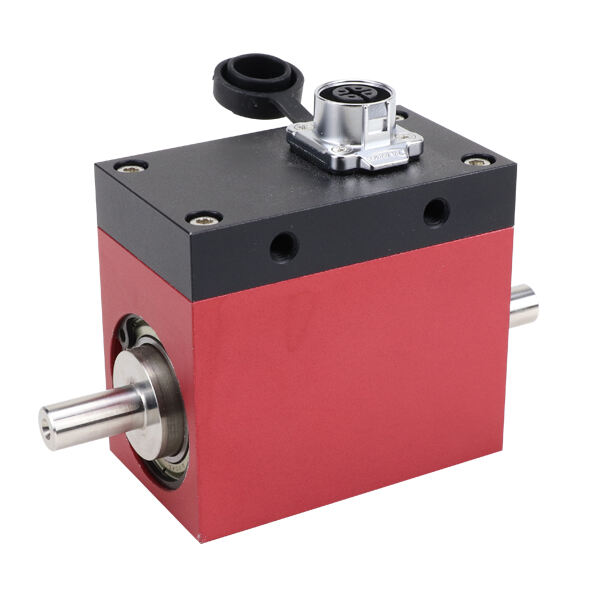Why Use a Torque Sensor in Electric Motor Testing?
Electric motors are integral to modern life, powering everything from industrial machinery and electric vehicles to household appliances and precision tools. As these motors become more advanced and energy-efficient, testing their performance accurately becomes increasingly important. One of the most vital components in electric motor testing is the Torque Sensor.
A Torque Sensor measures the rotational force produced by a motor, providing critical data on performance, efficiency, and operational health. Without accurate torque measurements, it’s impossible to fully understand how a motor will perform under real-world conditions. This article explores why a Torque Sensor is essential in electric motor testing, how it works, the benefits it offers, and how to choose the right sensor for your application.

Understanding What a Torque Sensor Is
A Torque Sensor, sometimes referred to as a torque transducer or torque meter, is a device that measures the torque (rotational force) applied to a shaft or other rotating system. In electric motor testing, torque is a direct indicator of how effectively the motor converts electrical energy into mechanical energy.
The Torque Sensor can provide either static measurements (torque without rotation) or dynamic measurements (torque during rotation). Depending on the testing requirements, both types may be relevant for evaluating motor performance.
How a Torque Sensor Works in Electric Motor Testing
In a typical motor test setup, the Torque Sensor is mounted between the motor output shaft and the load device (such as a dynamometer). As the motor rotates and applies force to the load, the sensor detects the resulting twist or strain in its shaft. This strain is converted into an electrical signal using strain gauge technology, magnetic measurement methods, or optical systems.
The steps are as follows:
Torque Application: The motor generates torque that is transferred through the sensor.
Measurement Conversion: The sensor detects the strain or deformation and converts it into an electrical signal.
Signal Processing: The signal is amplified and processed for display or recording.
Performance Analysis: Engineers use the torque data alongside other measurements such as rotational speed, current, and voltage to calculate efficiency and power output.

Why Torque Measurement Is Essential for Electric Motors
Evaluating Efficiency
Torque, combined with rotational speed, determines mechanical power output. By comparing power input (electrical) to power output (mechanical), engineers can accurately calculate efficiency.
Identifying Mechanical Losses
A drop in measured torque at a given electrical input can indicate issues such as bearing wear, misalignment, or excessive friction in the system.
Performance Benchmarking
Accurate torque data helps compare different motor designs, ensuring manufacturers choose the best configuration for specific applications.
Quality Control
During production, Torque Sensors can verify that every motor meets its design specifications before leaving the factory.
Safety Verification
In applications like electric vehicles or industrial equipment, testing ensures motors won’t produce excessive torque that could damage the system or cause safety hazards.
Benefits of Using a Torque Sensor in Electric Motor Testing
High Accuracy and Repeatability
A Torque Sensor delivers precise, repeatable measurements, ensuring test results are reliable and consistent.
Real-Time Data Acquisition
Dynamic Torque Sensors can provide live torque readings during motor operation, enabling instant performance analysis.
Versatility Across Applications
From small fractional horsepower motors to large industrial drives, Torque Sensors can be adapted to fit a wide range of test setups.
Early Fault Detection
Monitoring torque changes over time can reveal early signs of mechanical wear or electrical inefficiency, preventing costly failures.
Comprehensive Performance Analysis
When combined with other data such as speed, temperature, and vibration, torque measurements offer a complete picture of motor performance.
Types of Torque Sensors for Motor Testing
Rotary Torque Sensors
Designed to measure torque in rotating systems, these are ideal for most electric motor testing applications. They can be contact-based (slip rings) or non-contact (wireless signal transmission).
Reaction Torque Sensors
Measure torque in stationary systems where the shaft does not rotate. These are used for static load testing and calibration.
Inline Torque Sensors
Installed directly in the drive line between the motor and load, allowing seamless integration into test rigs.
Flange-Mount Torque Sensors
Offer a robust and compact design, often used in high-torque industrial motor testing environments.
Factors to Consider When Selecting a Torque Sensor
Torque Range: The sensor must accommodate the maximum torque expected during testing without overloading.
Accuracy Requirements: Choose a sensor with precision appropriate for your application, often expressed as a percentage of full-scale.
Speed Capability: For high-speed motors, ensure the sensor can handle the required rotational speed without signal loss or mechanical failure.
Mounting and Integration: Verify compatibility with your test setup, including shaft size, coupling, and alignment.
Environmental Conditions: Consider temperature, vibration, and exposure to contaminants.
Signal Output: Select between analog, digital, or wireless outputs based on your data acquisition system.
Common Applications of Torque Sensors in Motor Testing
Electric Vehicle Motor Testing
Torque Sensors measure the drive motor’s output to ensure it meets performance, range, and safety requirements.
Industrial Motor Performance Checks
Manufacturers use Torque Sensors to test motors powering pumps, conveyors, and compressors to ensure energy efficiency and reliability.
Research and Development
Engineers developing new motor technologies rely on torque data for design optimization.
Quality Control in Manufacturing
Every motor leaving the assembly line can be tested with a Torque Sensor to verify it meets specifications.
How Torque Sensors Improve Test Accuracy
Without a Torque Sensor, engineers might rely on indirect methods of estimating torque, which can introduce significant errors. A direct measurement eliminates many uncertainties, allowing for more precise calculations of efficiency, load capacity, and mechanical behavior.
For example, in an electric vehicle motor test, knowing the exact torque enables accurate simulation of road conditions, ensuring the motor will perform reliably in real-world driving.
Maintenance and Care of Torque Sensors
Regular Calibration: Ensures accuracy over time.
Proper Alignment: Misalignment can cause premature wear or measurement errors.
Clean Environment: Keep the sensor free from dust, oil, and moisture whenever possible.
Avoid Overload: Applying torque beyond the sensor’s rated capacity can permanently damage it.
Advances in Torque Sensor Technology
Non-Contact Transmission
Modern Torque Sensors use wireless telemetry or optical methods to transfer data without physical contact, reducing wear and maintenance needs.
Miniaturization
Compact Torque Sensors enable integration into small-scale applications, including robotics and medical devices.
Integrated Data Processing
Some sensors now include built-in electronics for signal conditioning, digital output, and diagnostics.
High-Speed Capability
Advances in materials and design allow sensors to handle ultra-high-speed motor testing without compromising accuracy.
The Future of Torque Measurement in Electric Motor Testing
As electric motors continue to evolve — becoming more powerful, efficient, and compact — Torque Sensors will remain essential for performance validation. Expect future developments to focus on:
AI-assisted torque data analysis for predictive maintenance.
Integration with cloud-based test systems for remote monitoring.
Sensors that combine torque measurement with vibration and temperature monitoring in a single unit.
These innovations will make Torque Sensors even more valuable for ensuring motors meet the demands of advanced industrial and transportation applications.
FAQ
What does a Torque Sensor measure?
It measures the rotational force applied to a shaft or system, providing data in real time for performance analysis.
Why is a Torque Sensor important in electric motor testing?
It allows precise measurement of output torque, which is critical for calculating efficiency, performance, and safety.
Can a Torque Sensor measure both static and dynamic torque?
Yes, depending on the design. Static torque sensors measure non-rotating torque, while dynamic torque sensors handle rotating systems.
How do I choose the right Torque Sensor for my motor test?
Consider torque range, speed, accuracy, environmental conditions, and compatibility with your test setup.
Are non-contact Torque Sensors better than contact types?
Non-contact sensors reduce wear and maintenance but may cost more; the choice depends on application requirements.
How often should Torque Sensors be calibrated?
Calibration frequency depends on usage and accuracy needs, but regular calibration is recommended to maintain reliability.
Can Torque Sensors handle high-speed motor testing?
Yes, many modern sensors are designed to operate at high rotational speeds without compromising accuracy.
Table of Contents
- Why Use a Torque Sensor in Electric Motor Testing?
- Understanding What a Torque Sensor Is
- How a Torque Sensor Works in Electric Motor Testing
- Why Torque Measurement Is Essential for Electric Motors
- Benefits of Using a Torque Sensor in Electric Motor Testing
- Types of Torque Sensors for Motor Testing
- Factors to Consider When Selecting a Torque Sensor
- Common Applications of Torque Sensors in Motor Testing
- How Torque Sensors Improve Test Accuracy
- Maintenance and Care of Torque Sensors
- Advances in Torque Sensor Technology
- The Future of Torque Measurement in Electric Motor Testing
-
FAQ
- What does a Torque Sensor measure?
- Why is a Torque Sensor important in electric motor testing?
- Can a Torque Sensor measure both static and dynamic torque?
- How do I choose the right Torque Sensor for my motor test?
- Are non-contact Torque Sensors better than contact types?
- How often should Torque Sensors be calibrated?
- Can Torque Sensors handle high-speed motor testing?
